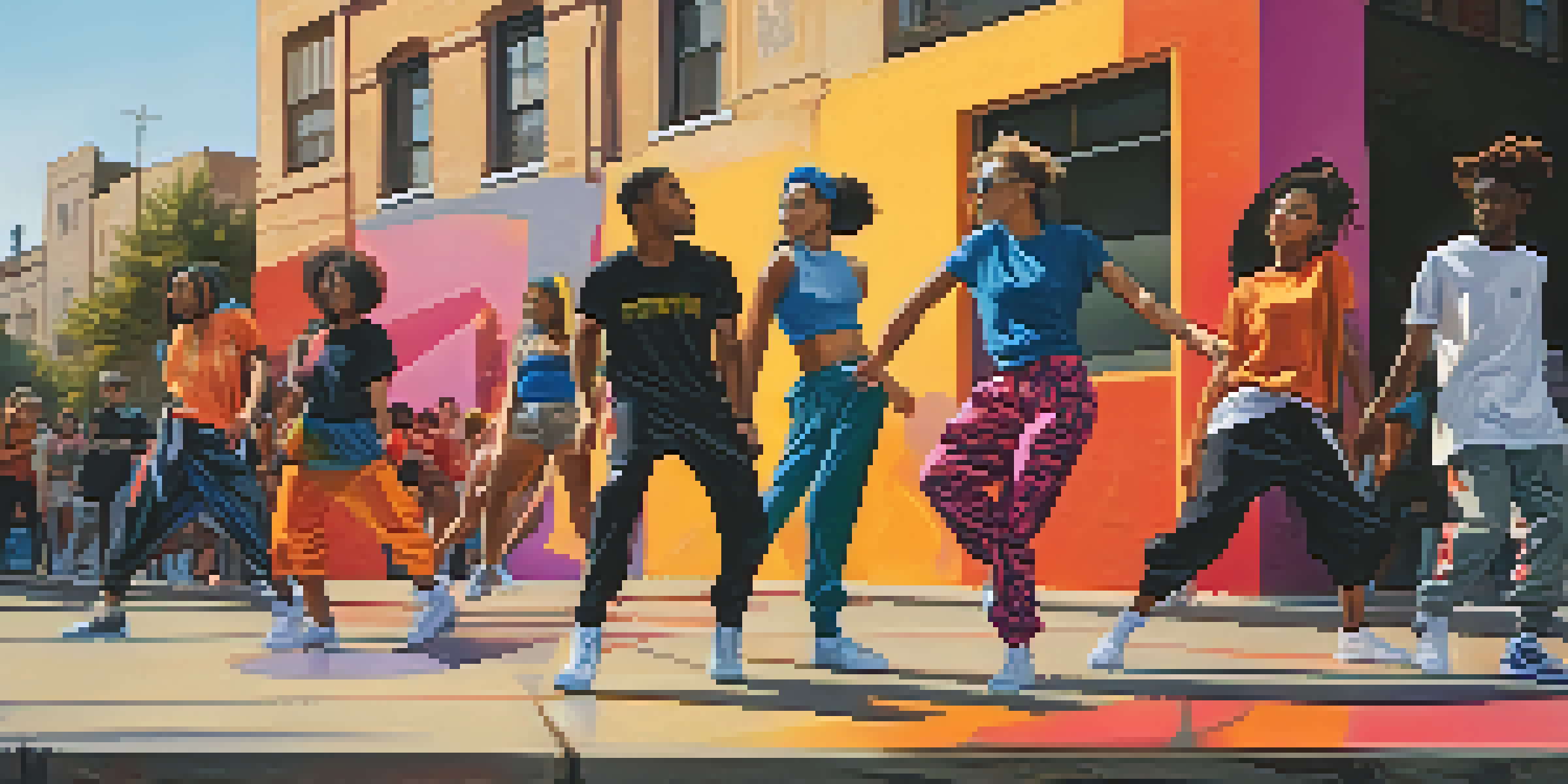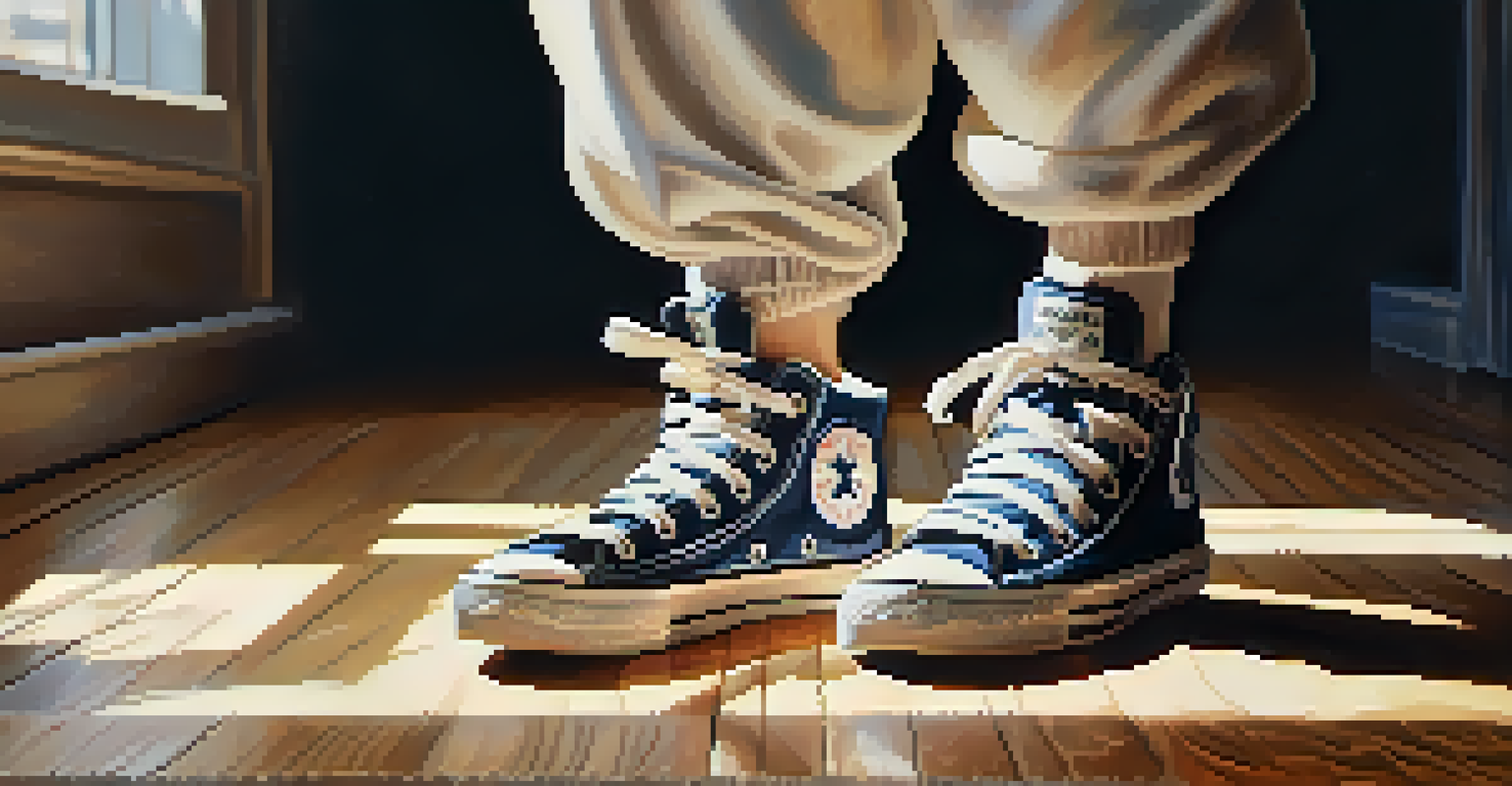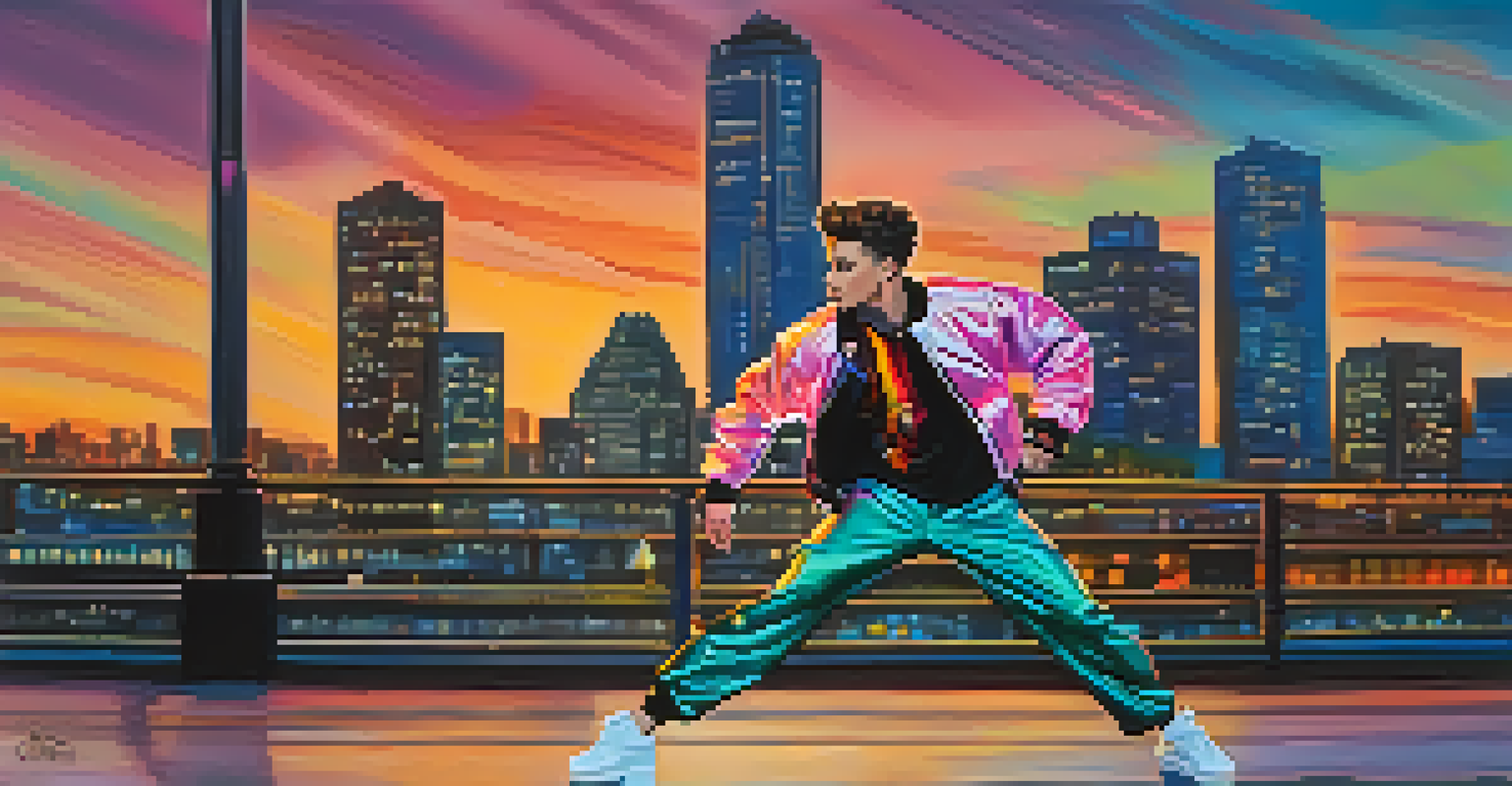Influence of Streetwear on Dance Performance Attire Trends

The Rise of Streetwear in Modern Culture
Streetwear has evolved from a niche fashion movement to a global phenomenon, deeply rooted in urban culture. Originating in the late 20th century, it embodies a blend of skate, hip-hop, and surf styles, allowing self-expression and individuality. This fashion genre has transcended into various sectors, influencing not just clothing but also music, art, and dance.
Fashion is the armor to survive the reality of everyday life.
As streetwear gains momentum, its aesthetic finds its way into dance communities, where performers seek attire that reflects their identity. The informal yet stylish nature of streetwear resonates with dancers who want to showcase their unique flair while maintaining comfort during performances. The result is a refreshing fusion of artistry and fashion that captivates audiences.
Dancers today are increasingly drawn to streetwear brands, which often feature bold graphics, loose fits, and vibrant colors. This trend represents a shift from traditional performance attire, allowing dancers to move freely while making a striking visual statement. Such attire not only enhances the dance experience but also brings an element of fun and playfulness to the art form.
Key Elements of Streetwear in Dance Fashion
When we think of streetwear, certain elements come to mind—oversized silhouettes, graphic tees, and statement sneakers. These components are now being embraced by dancers, who prioritize comfort and mobility alongside style. The loose-fitting garments allow performers to execute their moves without restriction, making them practical choices for rehearsals and performances alike.

Moreover, accessories play a significant role in this trend. Caps, bags, and even unique footwear have become integral to the dance outfit, contributing to a complete look that tells a story. Dancers are now seen incorporating these elements, elevating their performances while showcasing personal style at the same time.
Streetwear's Impact on Dance Culture
Streetwear has become a vital part of dance aesthetics, allowing performers to express individuality while prioritizing comfort.
The blending of these streetwear components with dance attire creates a dynamic visual experience. For instance, pairing a flashy bomber jacket with joggers and high-top sneakers not only looks great but also enhances the overall performance aesthetic. This combination allows dancers to express their individuality while adhering to the demands of their craft.
Cultural Connections: Streetwear and Dance Styles
Streetwear and dance have a symbiotic relationship, each influencing the other in profound ways. Many dance styles, such as hip-hop and breakdancing, originated in urban environments where streetwear was born. This cultural connection deepens the appreciation for both forms of art, as dancers draw inspiration from the street culture that surrounds them.
Style is a way to say who you are without having to speak.
As streetwear continues to evolve, new dance styles emerge that reflect these changes. For instance, the rise of TikTok has popularized various dance trends that often feature streetwear elements, blending choreography with fashion. This creates a powerful platform where dancers can showcase their skills while promoting their unique styles.
Furthermore, collaborations between streetwear brands and dance artists bring these two worlds even closer together. Limited-edition collections featuring dancers or choreographers not only celebrate the art form but also create a buzz around both fashion and dance, highlighting their interconnectedness in contemporary culture.
The Role of Social Media in Popularizing Trends
In today’s digital age, social media plays a pivotal role in shaping fashion trends, including dance attire. Platforms like Instagram and TikTok allow dancers to showcase their outfits and performances to a global audience, influencing others to adopt similar styles. This visibility helps streetwear gain traction within the dance community, creating a ripple effect that encourages more dancers to explore this fashion genre.
Dance challenges and viral videos often highlight the latest streetwear fashions, showcasing how these styles can elevate a performance. For instance, when a popular dancer wears a specific streetwear piece, it can quickly become sought after by fans and fellow dancers alike. This not only boosts the dancer's popularity but also propels the streetwear brand into the limelight.
Social Media Drives Fashion Trends
Platforms like Instagram and TikTok amplify the visibility of streetwear in dance, encouraging wider adoption of these styles.
Moreover, social media fosters a sense of community among dancers and fashion enthusiasts. Through hashtags and shares, individuals can connect over shared interests, further encouraging the integration of streetwear into dance culture. This community aspect not only promotes creativity but also empowers dancers to express themselves through their clothing choices.
Challenges in Merging Fashion with Functionality
While the integration of streetwear into dance attire is exciting, it also comes with challenges. One major concern is the balance between fashion and functionality. Dancers need outfits that not only look good but also support their movements and withstand rigorous performances. This can sometimes lead to compromises, where style overshadows comfort or practicality.
Additionally, the fast-paced nature of fashion trends can create pressure for dancers to constantly update their wardrobes. This can be both financially and mentally taxing, as performers navigate the need to stay relevant while also investing in pieces that enhance their craft. Finding the right balance between staying trendy and maintaining a sustainable wardrobe is an ongoing challenge.
Furthermore, not all streetwear brands prioritize the functional needs of dancers. Some may focus more on aesthetics, neglecting the specific requirements that come with dance performance. This highlights the importance of choosing the right brands and pieces that cater to both the artistic and practical aspects of dance.
Brand Collaborations and Influence on Dance Attire
Collaborations between streetwear brands and dancers have become increasingly popular, creating unique pieces that cater specifically to performance needs. These partnerships often result in limited-edition collections that fuse streetwear aesthetics with dance functionality, allowing dancers to express their style while also considering their movement requirements. This synergy creates a win-win situation for both brands and performers.
For example, when a renowned streetwear brand partners with a famous dancer to create a signature line, it not only boosts the dancer's brand but also introduces the streetwear culture to a broader audience. This collaboration can elevate the status of dance within the fashion world, showcasing it as an art form worthy of recognition and respect.
Fashion vs. Function in Dance Attire
Dancers face challenges in balancing stylish streetwear with the practical needs required for performance and movement.
Additionally, these collaborations often include feedback from dancers during the design process, ensuring that the final product meets both aesthetic and practical needs. This inclusivity fosters a sense of community and supports the continuous evolution of dance attire trends, making it an exciting time for performers looking to express themselves through their clothing.
The Future of Dance Attire: A Streetwear Perspective
Looking ahead, the future of dance attire seems poised for more significant influence from streetwear. As dance continues to gain popularity across various platforms, the demand for stylish yet functional performance wear will likely grow. This shift opens up opportunities for designers to innovate and create pieces that cater to the unique needs of dancers while remaining fashionable.
Furthermore, as more dancers become influencers in their own right, they will continue to shape the conversation around dance attire. Their platforms will serve as a stage to showcase how streetwear can merge with dance, inspiring others to embrace this unique blend of style and performance. This can lead to a more diverse range of options available for dancers at all levels.

Ultimately, as streetwear continues to evolve, it will undoubtedly leave a lasting mark on the world of dance. The fusion of these two vibrant cultures not only enriches the dance community but also encourages broader conversations about identity, self-expression, and the role of fashion in art. The future looks bright as we witness this exciting evolution unfold.